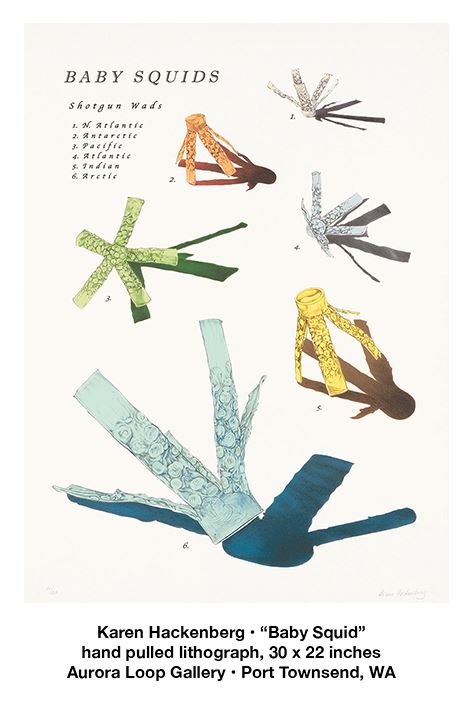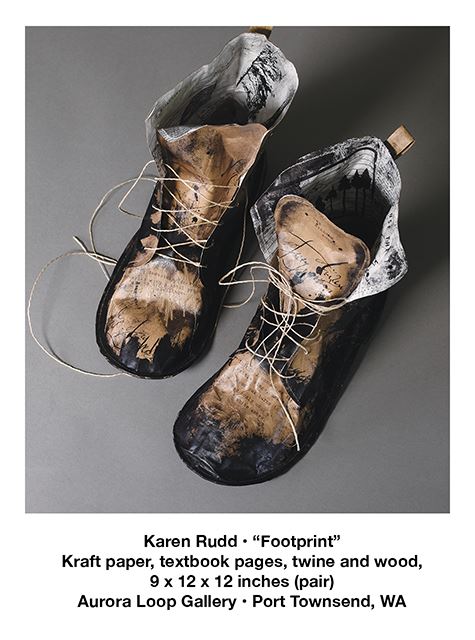.jpg)
A year ago, the Aurora Loop Gallery in Port Townsend was just an idea in the mind of artists Mary O’Shaughnessy and Charlie Van Gilder. The couple jumped in with confidence, having owned a successful gallery in Chicago before moving west in 2014. Their new gallery opened this past January, and now jumps into higher gear with its most ambitious show yet. It’s called “Process,” and is guest-curated by sculptor David Eisenhour. He has assembled an all-star line-up of artists, some with national and international reputations, all of whom call the Puget Sound region home.
What stands out is the exhibit’s diversity. Its profusion of form leaps out at a glance: small, quiet monotypes; dramatic abstract acrylics; elegant constructions made with bits of bark; sprawling wire and fabric sculptures; architectural renderings; post-Pop hyperreal paintings; and pairs of ink-stained shoes (we’ll come back to those).
The “Process” show achieves a thematic balance even with its mad-cap variety; intriguing correspondences between pieces and between artists emerge as you take in the work. (How each piece connects to the “Process” framework isn’t always evident—I’m still processing, I guess.)

Works by Aaron McKnight (sculptures) and Wendy Orville (monotype prints) have little in common physically, but a reverence for natural beauty unites them. McKnight meditates on the miniscule—seeds and leaf stems are sometimes the only construction materials he needs. For this show his design elements are birch tree lenticels (the “breathing holes” on a tree). Orville is drawn to the other end of the scale, capturing wide vistas in her monotypes, such as with her sweeping “Big Sky.” Though created by manually wiping ink from a plate and pressing the plate to paper, her monotypes seem to have a camera’s exactitude. Casual viewers assume they are photographs. McKnight and Orville transcend the human element in their work; their spacious and contemplative creations feel good to breathe in.
But now consider two artists mostly focused on the man-made: painter Karen Hackenberg and sculptor Karen Rudd. Their works address the precarity of the natural rather than its splendor. Hackenberg finds ironic ways to make sharp critiques of our throwaway culture. “Baby Squid” presents as a vintage specimen chart—so wholesome, such old-school charm—but its depictions are of spent shotgun shells. These non-biodegradable plastic “wads” get left behind by waterfowl hunters–and we are left to imagine their impact on a fragile habitat.

Karen Rudd contributes “Footprint,” pairs of shoes from a larger project staged last year, “Anthropocene.” That show featured realistic life-sized cedar stumps Rudd made out of sheets of cardboard. (Process that.)
The lumber industry workers and laborers of all kinds fascinate Rudd, who thoroughly researches their histories. She recreates their work clothing and their shoes using kraft paper from the Port Townsend paper mill. She stitches her own research materials—historic texts and photographs—onto the shoes. “Walking in someone else’s shoes” is one association we can make here, and “Carbon footprint” is another. For Rudd as for Hackenberg, the larger purpose is to confront our own exploitative behaviors, and to facethe “demon of extinction” (to borrow a phrase from Eisenhour).
The environment matters to Seattle-based sculptors Marita Dingus and June Sekiguchi, but people and communities are their primary focus. Both are public artists, both mothers, both involve ancestry, identity, and cross-cultural exchange ideas in their work. And yet in terms of process and output their creations differ. The found-object figure sculptures by Dingus delight in spontaneity and zany juxtaposition; by using repurposed materials she connects to African art traditions, where the practice has been embraced for centuries. Sekiguchi’s pieces are engineered and mathematical, celebrations of geometry and repetition. For this show Sekiguchi explores organic forms, perhaps a nod to the Olympic Peninsula setting. “Knothole, Reimagined 2” riffs on the wonder of nurse logs, with hand-carved fungal shapes sprouting to life on the edge of what remains of an ancient old-growth giant.

One last pairing: two artists who work two-dimensionally, and who happen to be at opposite ends of their careers. Albert Fisher first made waves in the 1960s as a disciple of Leo Kenney, and he remains active to this day. He is showing two abstract acrylics from the early 2000s: “Process: Fusion” brings to mind scenes in the film Oppenheimer that visualize subatomic physics. “Process: Finding” shows a circle in the center of the picture, a callback to Kenney-style geometric abstraction, elemental and pure. These are powerful and mysterious canvases.
Compared to many of the artists on the roster, Tacoma-based Blake Carter is a relative new-comer. We are fortunate to have more chances to experience his work. The human figure is Carter’s obsession: he crowds hundreds of figures into a single small piece, thousands of them into larger works. For all the repetition, each figure is individuated, hand-drawn with a loose efficiency. From across the room, the figures don’t register as such but as patterns; the piece as a whole draws you in with its energetic rhythms and rewards close-up attention with its nuance. The overall effect is hypnotic.
Tom McDonald
Tom McDonald is a writer and musician living on Bainbridge Island, Washington.
“Process” is on view through October 1 at the Aurora Loop Gallery, located at 971 Aurora Loop in Port Townsend, Washington. The gallery is open Thursday to Sunday from 12-5 p.m. Visit www.auroraloopgallery.com for more information.